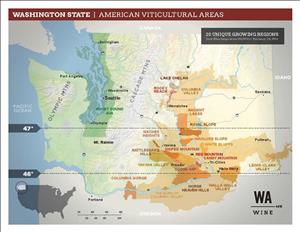On March 23, 1983, the U. S. Bureau of Alcohol, Tobacco, and Firearms designates the Yakima Valley as the first federally recognized wine grape growing region in Washington and the first north of California. The designation is known as an American Viticultural Area, or AVA, made at the request of wineries and vineyards to distinguish, elevate, and promote their products. When the Yakima Valley’s designation is announced, there are four wineries in the region: Kiona Vineyard and Winery, Hinzerling Winery, Yakima River Winery, and Tucker Cellars. Over time, the Yakima Valley AVA will be subdivided into four sub-appellations: Red Mountain, Snipes Mountain, Rattlesnake Hills, and Candy Mountain. Forty years later, the number of AVAs in Washington has increased to 20.
Shaping the Future of Washington Wines
On March 23, 1983, at the request of four winemakers in the Yakima Valley, the federal government designated the Yakima Valley an American Viticultural Area (AVA). An AVA designation benefits both wineries and consumers. "These designated grape growing regions, AVAs, allow vintners and wine enthusiasts to attribute unique characteristics, climatic features, quality, reputation, or other attributes of a wine made from grapes grown to its specific AVA geographic region ... It is beneficial for a winery to be a part of a prestigious or well-known AVA which garners more positive views on their vineyard’s grapes and finished wines. This allows the vintner to better market their wines and exact higher revenue" (Grape Adventures). The designation also allows consumers to better understand a wine’s characteristics before purchasing.
To be designated an AVA, the microclimate within the region must be deemed unique and consistent. Yakima Valley filled the bill. "Volcanic soils, sediments from Lake Missoula floods, wind-deposited loess soils, and finally ash deposits from the 1980 eruption of Mount St. Helens created a terrain nearly devoid of organic matter and pests common to the rest of the major wine- and hop-growing regions of the world. The rain-shadow effect created by the Cascade Mountain Range creates a desert climate that is key to preventing many diseases known to damage these crops. Reliable water supplies from a network of mountain reservoirs allow the precise application of irrigation as needed by the plants" ("Wine Scene: Craft Beverages ...").
The story of Yakima Valley wines began about a century before its AVA designation. Three individuals played pivotal roles. In 1869 the first grape vines in the valley were planted by French winemaker Charles Schanno on his family farm near Union Gap. The beginning of the modern wine industry is attributed to Seattle attorney William B. Bridgman (1878-1968), who began planting wine grapes in the heart of the Yakima Valley in 1917. "He became a committed advocate for the Washington wine industry, encouraging the use of European grape varietals to make traditional table wines" (“Upland Winery, the First ..."). Bridgman opened Upland Winery in 1934, a year after Prohibition was repealed. In 1937, Walter Clore (1911-2003), a horticulturist who worked at Washington State University’s Irrigation Branch Experiment Station in Prosser, started helping area farmers find the right wine grapes for their soil. Clore has since been recognized as "the father" of Washington wine by the Washington State Legislature. Additional experimentation and refinements continued for the next few decades.
Game Changer
Mike Wallace, an early Yakima Valley winemaker referred to as both "a character and a leader in the local wine industry" ("Prosser Reeling ..."), played a key role in urging his fellow winemakers to apply for the federal AVA designation. Raised in Seattle, Wallace had been stationed with the U.S. Air Force in Marin County, California, where he spent weekends exploring the wineries around Sonoma and Napa. In 1972, he moved to Prosser with his parents and started Hinzerling Winery in 1976 with his father.
Hinzerling Winery, along with Kiona Vineyard and Winery, Yakima River Winery, and Tucker Cellars – the four wineries in the region at the time – led the charge for the AVA application. "'Mike Wallace (Hinzerling Winery) was really the impetus,' said John Williams, one of the founders of Red Mountain and Kiona Vineyards. 'At the time, the ATF (Bureau of Alcohol, Tobacco and Firearms) governed AVA applications. There was a federal registry that had announced the opportunity to apply for an AVA designation. Mike really thought it was something we should do.' Williams and Randy Tucker of Tucker Cellars got together with Wallace (who died in 2016) and won them over. The three of them, along with the Yakima River Winery, formed a sort of loose wine growers association" ("Wine Scene: The Fascinating Story ...").
Each of the four winemakers took on a different part of the application; approval came within a few months. The new status was a game changer. "The AVA designation added a lot of value to both the Yakima Valley and Washington in terms of name recognition. At the time, it was the only AVA in the Pacific Northwest, so any time there was a write-up about Washington’s wine industry, the Yakima Valley was mentioned. That led to a lot of good press and notoriety" (Wine Scene: The Fascinating Story ...").
In 2023, the Yakima Valley AVA was home to more than 90 wineries and nearly 19,000 acres of vineyards, including some of Washington’s oldest and most venerable wineries. It produces about half of all Washington wine grapes and is one of the few regions in the state where white varieties outnumber red, led by Chardonnay and Riesling. Since its approval 40 years ago, the Yakima Valley AVA has been sub-divided and now includes the sub-appellations of Red Mountain, Snipes Mountain, Rattlesnake Hills, and Candy Mountain.

